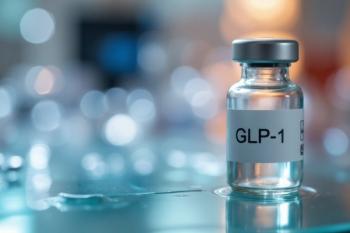
- November 2011 Cough & Cold
- Volume 77
- Issue 11
Living with Multiple Sclerosis
This complicated central nervous system disorder has many types and varying symptoms, and new treatments are available to help.
This complicated central nervous system disorder has many types and varying symptoms, and new treatments are available to help.
Multiple sclerosis (MS) is considered to be the most common neurologic disability among young adults in both Western Europe and North America.1,2 MS is classified as a recurrent, chronic demyelinating disorder affecting the central nervous system (CNS).2 According to the National Multiple Sclerosis Society, an estimated 400,000 individuals in the United States have a diagnosis of MS, with 100,000 new cases diagnosed annually, and as many as 2.5 million cases identified worldwide.2,3-5 Many individuals experience initial symptoms and receive the diagnosis between the ages of 15 and 50 years.3,6 The average age at diagnosis is 29 years in women and 31 years in men.5,6
Etiology and Epidemiology
MS is characterized as a chronic, unpredictable, immune-related inflammatory disease that attacks myelinated axons in the CNS, thus destroying the myelin and the axon in variable degrees.5,6 Although the exact cause of MS is unknown, many researchers attribute the etiology to an immunologic mechanism that causes the body’s immune system to attack the myelin sheath.6 This attack is thought to cause inflammation in the CNS, which may damage the myelin and ultimately injure the nerves.6-8
Others postulate that the risk of developing MS is related to interactions among the many genes that influence the immune system or to environmental factors, possibly involving certain viruses, vitamin D, and sun exposure.3,6-8 In all parts of the world, MS is more common at northern latitudes that are farther from the equator and less common in regions closer to the equator. 3 Researchers are now studying whether increased exposure to sunlight and to vitamin D have a protective effect. 3,8
whom the onset of MS is before the age of 15 years or after age 50 years, thus suggesting a hormonal component to the disease process.5 In addition, men have a greater tendency to develop primary progressive MS, whereas women tend to experience more relapses.3-6 Cigarette smoking also appears to increase the risk of developing MS, and women who smoke are 1.6 times more likely to develop the disease.3
Patients with a diagnosis of MS should be informed that having this condition does not shorten life expectancy, and that the effects of MS vary from person to person.4 Some individuals may experience symptoms for a short time, then remain in remission for several months or years, although others have continual progression. Some studies report that at least 10 years after diagnosis, approximately 50% of patients need to use a cane to walk and 15% require a wheelchair.4
Types of MS
There are 4 disease courses that have been identified in MS. Relapsing-remitting MS (RRMS) is the most common form, affecting approximately 85% of patients at diagnosis.7 MS manifests in varied patterns, as shown in Table 1.4,7,8 symptoms of ms Patients may have a broad range of symptoms on presentation that are often unpredictable and vary in occurrence and severity from patient to patient.6 The most common symptoms include numbness in the limbs, muscle weakness, paralysis, and vision distortion or impairment, or a combination of these.2,6,8,9 Other common symptoms are shown in Table 2.
Treating MS
In general, the goals for the treatment and management of MS include shortening the duration and frequency of exacerbations and relapses, providing relief of symptoms, maintaining the patient’s ability to walk, providing emotional support, and improving overall quality of life. 10,11
Although there is no cure for MS, various therapies are available. Current management of MS varies from patient to patient, and successful treatment plans may include a combination of pharmacologic agents, physical and occupational therapy, exercise programs, and eating a balanced diet.10 When used in combination, these therapies may enhance overall quality of life.10,11
Disease-Modifying Drugs
For the long-term treatment and management of MS, most physicians prescribe disease-modifying antirheumatic drugs (DMARDs), which slow the natural progression of the disease, decrease the frequency and severity of exacerbations, and reduce the accumulation of lesions within the brain and spinal cord.6,12
Management of Acute Exacerbations
Acute exacerbations of MS manifest as a result of inflammation of the CNS that causes damage to the myelin and slows or blocks the transmission of nerve impulses.13 To be classified as a true exacerbation, the attack must last at least 24 hours and be separated from a previous exacerbation by at least 30 days.13 Exacerbations can last from a few days to several weeks or months and can range from mild to severe enough to interfere with the ability to perform day-to-day activities.13
Corticosteroid therapy via intravenous administration, oral steroids, or both, is typically prescribed to minimize the duration of acute relapses as well as to attempt to prevent any long-term damage that may be caused by an exacerbation.8,13,14
There are also effective therapies for managing various secondary symptoms associated with MS. For example, fatigue is very common, affecting an estimated 78% of patients and often interfering with daily activities. 8,13,14 Fatigue may be managed with agents such as amantadine (Symmetrel) or modafinil (Provigil). Although neither agent is approved by the FDA for MS, these agents are commonly prescribed for the management of MS-related fatigue. 8,13,14 Depression is also very common, affecting an estimated 20% of patients with MS. Antidepressants, such as selective serotonin reuptake inhibitors, may be useful after careful symptom evaluation. 8,13,14
More than 48% of MS patients experience significant pain. 13,14 Neuropathic pain is often managed with the use of gabapentin (Neurontin), which also helps to relieve spasticity. 8 Anticonvulsants such as carbamazepine (Tegretol) and phenytoin (Dilantin), tricyclic antidepressants (ie, nortriptyline, amitriptyline), and nonsteroidal anti-inflammatory drugs are also frequently prescribed to manage neuropathic pain.8,13,14 Spasticity may be managed by using baclofen (Lioresal), tizanidine (Zanaflex), or clonazepam (Klonopin), and bladder urgency with oxybutynin (Ditropan, Ditropan XL) or tolterodine (Detrol).8
Effective symptom management involves not only the use of pharmacologic agents, but also physical therapy, selfcare techniques, counseling and support therapy, and exercise and stretching programs tailored to meet individual needs.2 A comprehensive list of pharmacologic agents commonly used in managing MS symptoms can be found on the National Multiple Sclerosis society Web site.
New Treatments for MS
In January 2010, the FDA approved dalfampridine (Ampyra), the first in a new class of MS agents known as potassium channel blockers. It is specifically indicated to improve ambulation in MS patients. 15 Although dalfampridine is believed to enhance conduction in damaged nerves, the exact mechanism by which dalfampridine exerts its therapeutic effect is not fully known. 15 It is available as an extended-release tablet for oral administration, with a maximum recommended dose of 10 mg twice daily, approximately 12 hours apart, and it can be taken with or without food. Advise patients not to take double or extra doses if a dose is missed. 15 The most common adverse effects of this agent include dizziness, headache, nausea, diarrhea, indigestion, and throat pain. 15 Dalfampridine is contraindicated for use in those patients with a history of seizures and with moderate or severe renal impairment. 15
In March 2010, the FDA approved a new indication for onabotulinumtoxinA (Botox), providing another treatment option for people with MS or other disorders who may experience spasticity in the muscles of the elbows, wrists, and fingers. 16 Spasticity is an often painful muscle tightness that can make mobility difficult. In clinical trials largely involving people with spasticity after stroke, targeted injections of Botox into muscles produced favorable and safe results.16 OnabotulinumtoxinA is also FDA approved to treat urinary incontinence resulting from overactivity of the bladder detrusor muscle caused by MS or other neurologic conditions in adults who have an inadequate response to anticholinergic medications or are unable to tolerate them.17
On September 22, 2010, the FDA approved fingolimod (Gilenya) for the treatment of RRMS. Gilenya is indicated for the treatment of patients with relapsing forms of multiple sclerosis (MS) to reduce the frequency of clinical exacerbations and to delay the accumulation of physical disability.18 It is classified as an immunosuppressant, and is the first oncedaily oral tablet for MS that can offer convenience over injection therapies.18 Clinical studies demonstrate that this agent significantly decreases MS attacks when compared with placebo or intramuscular interferon beta-1a.6,18-20
Fingolimod is the first drug in its class and has a novel mechanism of action because it binds to the sphingosine-1 phosphate receptor on the surfaces of white blood cells (WBCs).19,20 These WBCs are then trapped in the lymph nodes, resulting in a decreased level of recirculating WBCs in the body.19,20 The recommended dose is 0.5 mg orally once daily, and it can be administered without regard to food.18 Patients should be advised that the use of fingolimod can cause bradycardia, increased risk of infections, and macularedema.18 Patients should be observed for 6 hours after the first dose to monitor for signs and symptoms of bradycardia.18 Common adverse effects include nausea, fatigue, initial decreases in heart rate, upper respiratory tract infections, fluid accumulation under the macula of the eye, increased hepatic enzymes, and increased blood pressure.6,19,20
Ongoing research is investigating other possible oral therapies. The October 6, 2011, issue of The New England Journal of Medicine reported that the results from the phase 3 study of the new oral diseasemodifying drug teriflunomide showed a reduction in relapse rates and slowed disease progression in patients with relapsing forms of MS. 21 More information about MS clinical trials can be found at the National Institutes of Health Web site at
Conclusion
During counseling, it is imperative that patients clearly understand how to properly take their medications and be aware of any possible adverse effects. The importance of adhering to the treatment plan should be stressed. Patients should be encouraged to maintain routine checkups with their primary health care provider and to discuss any concerns, especially if symptoms worsen or they have any adverse drug reactions.
All patients, especially those with a recent diagnosis of MS, should be informed of the available resources and support groups that may aid in coping with the disease. Patients with MS may benefit from an exercise program early in the course of the disease. The importance of establishing a good nutritional plan, getting sufficient rest, incorporating relaxation techniques into the daily routine, and avoiding stress and temperature extremes should be emphasized.
Because many MS patients may be taking several medications, it is imperative that screening for possible drug—drug interactions and contraindications be performed. Patients should be advised to consult with their primary health care provider before taking any nonprescription drugs or alternative medications.
Pharmacists should keep abreast of the ongoing developments in the management and treatment of MS, giving patients the most current information to assist them with informed decision making about possible treatment options. As health care professionals, we should show patients and caregivers empathy and provide encouragement as they learn to live with the physical and emotional challenges presented by MS.
Patients should be reminded that by adhering to recommended treatment plans, they can lead normal, productive lives, and they should also be encouraged to seek help when needed. Although there is no cure for MS, information about ongoing research and new treatments can arm patients with the hope they need to help them effectively manage this complex disease. PT
Ms. Terrie is a clinical pharmacy writer based in Haymarket, Virginia.
References
1. Conway D, Cohen JA. Combination therapy in multiple sclerosis. Lancet Neurol. 2010;9(3):299-308.
2. Multiple sclerosis. In: Bope ET et al, eds. Conn’s Current Therapy 2010. MD Consult Web
3. Who gets MS? Multiple Sclerosis Association of America Web site. www.msassociation.org/about_multiple_sclerosis/whogets/. Accessed October 14, 2011.
4. Courtney AM, Treadaway K, Remington G, Frohman E. Multiple sclerosis. Med Clin North Am. 2009;93(2):451-476.
5. Luzzio C. Multiple sclerosis. Medscape Web site. http://emedicine.medscape.com/article/1146199-overview. Accessed October 14, 2011.
6. Theodorou AA, Johnson KM, Ruf S, Szychowski JA. Prescription utilization by multiple sclerosis patients in the United States. Am J Pharm Benefits. 2010;2(2)147-151. www.ajpblive.com/issues/2010/vol2_no2/DrugTrends_2-2. Accessed October 15, 2011.
7. About MS. National Multiple Sclerosis Society Web site. www.nationalmssociety.org/about-multiple-sclerosis/index.aspx. Accessed October 15, 2011.
8. Multiple sclerosis. In: Ferri FF, ed. Practical Guide to the Care of the Medical Patient. 7th ed. MD Consult Web site. www.mdconsult.com/das/book/body/210428425-4/1027166273/1417/998.html. Accessed October 14, 2011.
9. What are the symptoms of MS? Multiple Sclerosis Association of America Web site. www.msassociation.org/about_multiple_sclerosis/symptoms/. Accessed October 14, 2011.
10. Treatments. National Multiple Sclerosis Society Web site. www.nationalmssociety.org/about-multiple-sclerosis/what-we-know-about-ms/treatments/index.aspx. Accessed October 14, 2011.
11. Multiple sclerosis. In: Bradley WG, Fenichel G, Jankovic J, eds. Neurology in Clinical Practice. 5th ed. 2008. MD Consult Web site. www.mdconsult.com/book/player/book.do?method=display&type=bookPage&decorator=header&eid=4-u1.0-B978-0-7506-7525-3..50092-3--cesec45&uniq=210224438&isbn=978-0-7506-7525-3. Accessed October 14, 2011.
12. FDA-approved disease modifying agents. National Multiple Sclerosis Society Web site. www.nationalmssociety.org/about-multiple-sclerosis/what-we-know-about-ms/treatments/index.aspx. Accessed October 15, 2011.
13. Treating exacerbations. National Multiple Sclerosis Society Web site. www.nationalmssociety.org/about-multiple-sclerosis/what-we-know-about-ms/treatments/index.aspx#exacerbations. Accessed October 15, 2011.
14. Exacerbation management. Multiple Sclerosis Association of America Web site. www.msassociation.org/about_multiple_sclerosis/medications/types/exacerbation.asp. Accessed October 14, 2011.
15. Ampyra (dalfampridine) [prescribing information]. Hawthorne, NY: Acorda Therapeutics, Inc; 2010.
16. FDA approves Botox for treating spasticity, or tightness, in upper limbs. National Multiple Sclerosis Society Web site. www.nationalmssociety.org/news/news-detail/index.aspx?nid=2875. Accessed October 15, 2011.
17. Botox. National Multiple Sclerosis Society Web site. www.nationalmssociety.org/about-multiple-sclerosis/what-we-know-about-ms/treatments/medications/botox/index.aspx. Accessed October 15, 2011.
18. Gilenya Prescribing Information. Novartis Web site. www.pharma.us.novartis.com/product/pi/pdf/gilenya.pdf. Accessed October 15, 2011.
19. Novartis oral multiple sclerosis development compound Gilenia (FTY720) granted US priority review status. Media release, September 22, 2010. Novartis Web site. www.novartis.com/newsroom/media-releases/en/2010/1445917.shtml. Accessed October 15, 2011.
20. Cohen JA, Barkhof F, Comi G, et al. Oral fingolimod or intramuscular interferon for relapsing multiple sclerosis. N Engl J Med. 2010;362:402-415.
21. Oral teriflunomide promising for relapsing MS. Medscape Web site. www.medscape.com/viewarticle/751069. Accessed October 15,
Articles in this issue
about 14 years ago
Compounding Hotlineabout 14 years ago
Cough & Cold Watchabout 14 years ago
Patient Privacy At Stake in Health IT Boomabout 14 years ago
Can You Read These Rxs?about 14 years ago
Case Studiesabout 14 years ago
Cholesterol Watchabout 14 years ago
Breast Cancer Watchabout 14 years ago
Influenza vs the Common Cold: Symptoms and Treatmentabout 14 years ago
Aging Well in the Digital Ageabout 14 years ago
Tech Product NewsNewsletter
Stay informed on drug updates, treatment guidelines, and pharmacy practice trends—subscribe to Pharmacy Times for weekly clinical insights.














































































































































































































